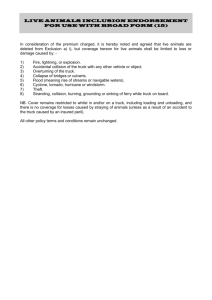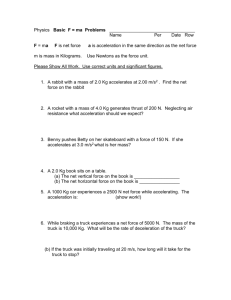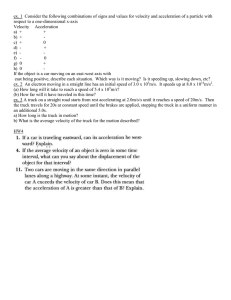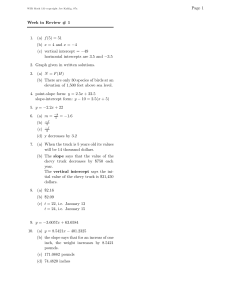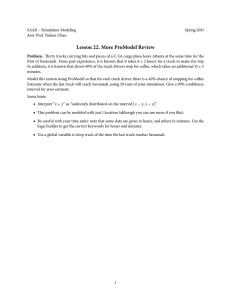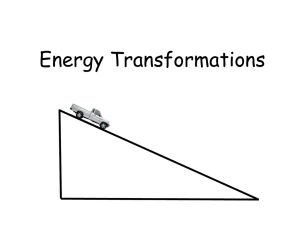Experimental Demonstrations of Real-time MILP Control Arthur Richards , Yoshiaki Kuwata,
advertisement
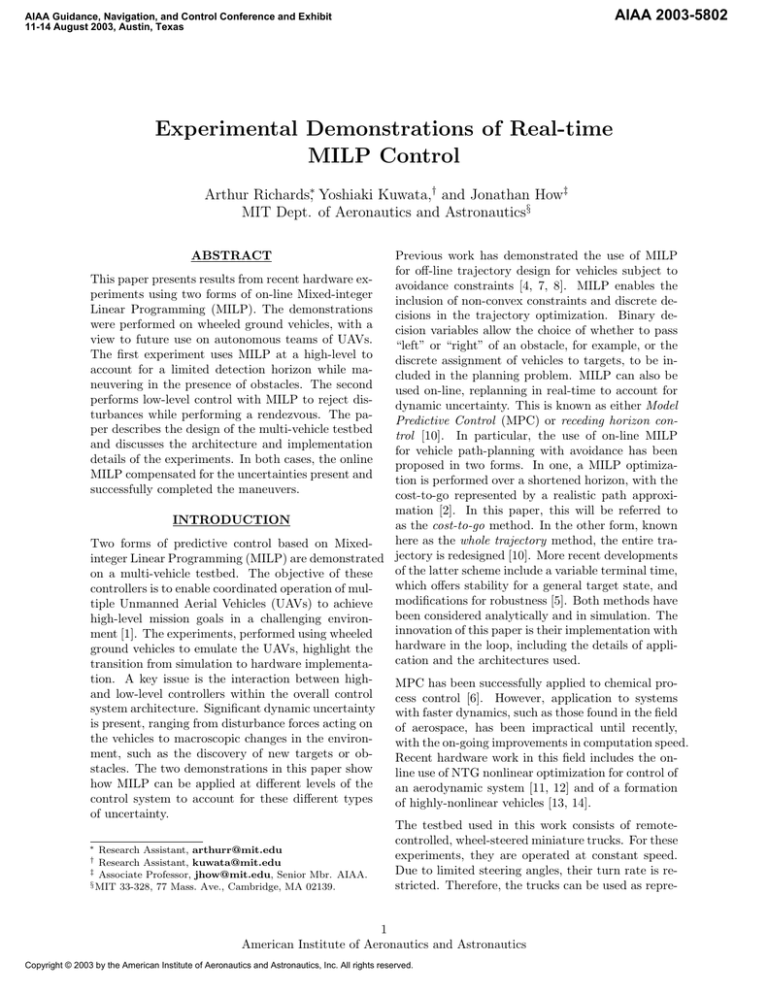
AIAA Guidance, Navigation, and Control Conference and Exhibit
11-14 August 2003, Austin, Texas
AIAA 2003-5802
Experimental Demonstrations of Real-time
MILP Control
Arthur Richards∗, Yoshiaki Kuwata,† and Jonathan How‡
MIT Dept. of Aeronautics and Astronautics§
Previous work has demonstrated the use of MILP
for off-line trajectory design for vehicles subject to
This paper presents results from recent hardware exavoidance constraints [4, 7, 8]. MILP enables the
periments using two forms of on-line Mixed-integer
inclusion of non-convex constraints and discrete deLinear Programming (MILP). The demonstrations
cisions in the trajectory optimization. Binary dewere performed on wheeled ground vehicles, with a
cision variables allow the choice of whether to pass
view to future use on autonomous teams of UAVs.
“left” or “right” of an obstacle, for example, or the
The first experiment uses MILP at a high-level to
discrete assignment of vehicles to targets, to be inaccount for a limited detection horizon while macluded in the planning problem. MILP can also be
neuvering in the presence of obstacles. The second
used on-line, replanning in real-time to account for
performs low-level control with MILP to reject disdynamic uncertainty. This is known as either Model
turbances while performing a rendezvous. The paPredictive Control (MPC) or receding horizon conper describes the design of the multi-vehicle testbed
trol [10]. In particular, the use of on-line MILP
and discusses the architecture and implementation
for vehicle path-planning with avoidance has been
details of the experiments. In both cases, the online
proposed in two forms. In one, a MILP optimizaMILP compensated for the uncertainties present and
tion is performed over a shortened horizon, with the
successfully completed the maneuvers.
cost-to-go represented by a realistic path approximation [2]. In this paper, this will be referred to
INTRODUCTION
as the cost-to-go method. In the other form, known
here
as the whole trajectory method, the entire traTwo forms of predictive control based on Mixedjectory
is redesigned [10]. More recent developments
integer Linear Programming (MILP) are demonstrated
of
the
latter
scheme include a variable terminal time,
on a multi-vehicle testbed. The objective of these
which
offers
stability for a general target state, and
controllers is to enable coordinated operation of mulmodifications
for robustness [5]. Both methods have
tiple Unmanned Aerial Vehicles (UAVs) to achieve
been
considered
analytically and in simulation. The
high-level mission goals in a challenging environinnovation
of
this
paper is their implementation with
ment [1]. The experiments, performed using wheeled
hardware
in
the
loop,
including the details of appliground vehicles to emulate the UAVs, highlight the
cation
and
the
architectures
used.
transition from simulation to hardware implementation. A key issue is the interaction between highMPC has been successfully applied to chemical proand low-level controllers within the overall control
cess control [6]. However, application to systems
system architecture. Significant dynamic uncertainty
with faster dynamics, such as those found in the field
is present, ranging from disturbance forces acting on
of aerospace, has been impractical until recently,
the vehicles to macroscopic changes in the environwith the on-going improvements in computation speed.
ment, such as the discovery of new targets or obRecent hardware work in this field includes the onstacles. The two demonstrations in this paper show
line use of NTG nonlinear optimization for control of
how MILP can be applied at different levels of the
an aerodynamic system [11, 12] and of a formation
control system to account for these different types
of highly-nonlinear vehicles [13, 14].
of uncertainty.
The testbed used in this work consists of remotecontrolled, wheel-steered miniature trucks. For these
∗ Research Assistant, arthurr@mit.edu
experiments, they are operated at constant speed.
† Research Assistant, kuwata@mit.edu
Due to limited steering angles, their turn rate is re‡ Associate Professor, jhow@mit.edu, Senior Mbr. AIAA.
§ MIT 33-328, 77 Mass. Ave., Cambridge, MA 02139.
stricted. Therefore, the trucks can be used as repreABSTRACT
1
American Institute of Aeronautics and Astronautics
Copyright © 2003 by the American Institute of Aeronautics and Astronautics, Inc. All rights reserved.
sentative models of UAVs, which would typically operate at a constant, nominal speed, flying at a fixed
altitude and with turning rate limited by the achievable bank angle. The vehicles have on-board computers and wireless LAN communications, offering a
flexible architecture for demonstrating co-operative
control.
In the first demonstration, the cost-to-go method [2]
is used as a “high-level” controller to compensate for
uncertainty in the environment. It designs a series
of waypoints for the truck to follow. A “low-level”
controller then steers the truck to move along this
path. An obstacle exists between the vehicle and
its goal, but the controller does not become aware
of this until it comes within a “detection horizon” of
the obstacle. This represents operation using sensors
with limited range, such as radar, which can detect
obstacles only within a certain radius.
In the second demonstration, the low-level controller
is removed and the on-line MILP is used to compensate for disturbances acting upon the vehicle. The
whole-trajectory formulation is used [5], including
modifications to ensure feasibility of the MILP at
each step. Two vehicles are used: one is driven
open-loop as a target while the other is controlled
by MPC to perform a rendezvous with the first. The
MPC must compensate for uncertain motion of both
trucks. For the purposes of the experiments, the
choice of a rendezvous maneuver adds the unknown
target motion to the sources of uncertainty. In practice, such a maneuver could represent in-flight refuelling of a UAV.
(a) Waypoint Mode
This paper begins with a description of the truck
testbed used, which is common to both demonstrations. Each is then discussed separately, including
specific objectives, controller formulations, integration with the testbed, test scenarios, procedures and
results.
APPARATUS DESCRIPTION
The testbed for this experiment consists of two selfcontained, remotely-controlled trucks. They can be
operated in two distinct modes. Fig. 1(a) shows
the architecture and loop closure in waypoint mode,
in which the high-level controller provides a set of
waypoints to the trucks and a low-level controller
moves between them. In direct steer mode, shown in
Fig. 1(b), the high-level controller generates steering
commands for the truck, while a low-level controller
maintains a desired speed. The major components
are described separately in the following sections.
(b) Direct Steer Mode
Fig. 1: Testbed Architecture showing Control Loops
in Both Modes
2
American Institute of Aeronautics and Astronautics
of the plan are sent to the base-station. In directsteer mode, a steering angle is computed for the
first plan step and sent to the base-station for direct relay to the truck. MATLAB is used to manage communications, data recording, visualization
and data conversion. The planner uses CPLEX optimization software [16] to solve the MILP problems,
using AMPL [15] as the interface between CPLEX
and MATLAB.
Operating Limits
Fig. 2: Testbed vehicles.
Trucks
Fig. 2 shows three of the trucks. Each is based on
a commercially available model truck. Each carries a laptop PC on-board, the functions of which
are described in the next section. Physically, it is
connected by serial links to a PWM converter, generating signals for the motor speed controller and
steering servo, and to a GPS receiver. The batteries
and power supply circuitry complete the on-board
hardware, making each truck an independent unit.
A video camera can also be mounted on-board for
demonstration purposes.
On-Board Computer
This laptop computer on each truck performs local estimation and low-level control functions. It
performs precise relative position and velocity estimation using differential carrier-phase GPS [17]. A
fixed GPS base station, not shown in Fig. 1, communicates with the on-board PC via wireless LAN to
enable differential GPS. The estimation is performed
at a rate of 5 Hz. A speed control loop is closed on
the laptop, generating motor servo commands in order to maintain a constant reference speed. In waypoint mode, an additional steering controller acts to
follow a list of waypoints. In direct steer mode, the
steering servo command is relayed directly from a
higher-level controller. The higher level commands
(reference speed, waypoint list and steering command) are sent via wireless LAN from the planner
computer. To close the loop, the GPS state estimates are sent to the planner at a rate of 1 Hz.
Planner
This laptop computer performs the MILP optimizations. In waypoint mode, the first few waypoints
To achieve as much as possible in a confined space,
the trucks are operated at a low speed (nominal running speed is 0.5 m/s). At lower speeds, friction
effects made the speed control unreliable. At this
speed, the available steering range sets the minimum
turn radius to approximately 1 m.
COST-TO-GO DEMONSTRATION
In these experiments, the receding-horizon MILP
formulation with the approximate cost-to-go function [2] is used to compensate for uncertainty in
the obstacle environment beyond a limited detection horizon. In this case, disturbances acting on
the truck are assumed to be handled by the lowlevel feedback control system. The detection radius
effect is simulated, since the actual trucks have no
real obstacle sensors. For simplicity, the controller is
given the size and location of the complete obstacle
as soon as its detection radius intersects part of the
obstacle [3].
The following subsection reviews the receding horizon formulation. In the final subsection, the results
are presented and interpreted.
Review of Receding Horizon Control
For review, the cost-to-go formulation for the minimum time path planning problem is briefly presented here [2]. This algorithm designs the minimumtime path to a fixed goal while avoiding a known set
of obstacles. Operation in the presence of the limited
detection horizon is described in the next subsection.
Fig. 3 gives an overview of the method, including the
different levels of resolution involved.
The control strategy is comprised of two phases: cost
estimation and trajectory design. The cost estimation estimates the cost-to-go from each obstacle corner. The procedure is as follows:
1. Form a graph by connecting every obstacle corner to all other obstacle corners using straight
lines.
3
American Institute of Aeronautics and Astronautics
The values of θi are uniformly distributed between
0 and 2π. By limiting the components of the vector
quantities in each of these directions, an approximate limit on their two-norms is effected in linear
form [8]. A point mass dynamic model subject to
the 2-norm force and speed constraints (2) and (3)
forms a good approximate model for limited turnrate vehicles, provided that the optimization favors
the minimum time, or minimum distance, path [8].
Fig. 3: Overview of Cost-to-Go Method.
2. Remove those edges that intercept obstacles.
3. Use Dijkstra’s Single-Source Shortest-Path Algorithm to find the “tree” of optimal paths
from the goal to each corner.
4. Store the cost-to-go from each corner along the
calculated path.
The development of this set of approximate costs is
based on the observation that the true optimal paths
(i.e. minimum distance) tend to follow the edges and
corners of the obstacles. In Fig. 3, each of the “cost
points” is marked by + and the associated paths are
the solid black lines. Note that it is not necessary
to store the paths: only the cost values are needed.
In the trajectory design phase, MILP optimizations
are solved to design a series of short trajectory segments over a planning horizon with length N steps.
In Fig. 3, this section of the plan is shown by the
dashed black line. Each optimization finds a control sequence {uk|k . . . uk|(k+N −1) } and corresponding states {xk|k . . . xk|(k+N ) }, where uk|j denotes the
control designed at time k for application at time j
and each state is comprised of a position and velocity i.e. x = (r v). These states are subject to the
dynamics constraint
∀j ∈ [k . . . (k + N − 1)] xk|(j+1) = Axk|j + Buk|j (1)
where A and B are the discretized system dynamics matrices for a point mass in 2-D free-space. The
speed and force are limited, using the following approximation for a 2-norm [8]
∀j ∈ [k . . . (k + N )] Wvk|j ≤ 1vmax
(2)
∀j ∈ [k . . . (k + N )] Wuk|j ≤ 1fmax
(3)
where 1 is a vector of 1’s and W has the structure
...
...
(4)
W = cos(θi ) sin(θi )
...
...
The MILP also chooses a “visible point” rvis which
is visible from the “terminal point” rk|k+N and from
which the cost-to-go has been estimated, Cvis , in the
previous phase. These points are shown in Fig. 3.
Note that the cost map is quite sparse: cost-to-go
values are only known for the corners of the obstacles. The distance from the terminal point to the
visible point is approximated in the cost function,
allowing the cost-to-go to be evaluated at a freelychosen terminal point using only a sparse grid of cost
points. Since the optimal trajectories usually pass
through obstacle vertices, this is a valid approximation and the performance remains close to the true
optimal [2]. The map does not need to be recalculated at each step: it is valid as long as the obstacles
are known and stationary. Changes in the obstacle
field are dealt with by replanning, as discussed in
the next section.
The following avoidance constraints are applied at
each point of the dynamic segment and at intermediate points between the terminal point and the visible
point. Rectangular obstacles are used in this formulation, and are described by their lower left corner
(ulow , vlow ) and upper right corner (uhigh , vhigh ). To
avoid collisions, the following constraints must be
satisfied at each point on the trajectory [9]
rk|j,1
rk|j,1
rk|j,2
rk|j,2
4
X
≤
≥
≤
≥
ulow + R bin,1
uhigh − R bin,2
vlow + R bin,3
vhigh − R bin,4
bin,j ≤ 3
(5)
(6)
j=1
The trajectory cost involves three terms: the cost
of the steps to the terminal point rk|k+N ; the approximate straight-line cost from the terminal point
to the visible point `vis = krk|k+N − rvis k ; and the
cost from the visible point to the goal Cvis . Referring to Fig. 3, these represent the black dashed line,
the gray line, and the black solid line, respectively.
Assuming that the first part of the plan is flown at
4
American Institute of Aeronautics and Astronautics
constant speed, its distance is constant and it can
be ignored in the cost function. This assumption is
valid for the minimum distance, limited speed problem [8]. Only the distance to the visible point and
the remaining straight-line approxmate path are included. The actual cost function is
`vis
∗
J = min
+ Cvis
(7)
u(·) vmax
with Eq. (1) – (6) as constraints. The following constraints determine `vis
W(rk|k+N − rvis ) ≤ 1`vis
(8)
This approximates the two-norm of the distance from
the terminal point to the visible point, by approximating the smallest circle to enclose that vector.
Detection Horizon Application
This section describes the application of the formulation in the previous section to the truck demonstration. The truck was modeled as having maximum
speed 0.5 m/s, equal to the nominal running speed.
The modeled maximum turn rate was 7 deg/s, chosen to give smooth operation when using the lowlevel steering controller: the planner sends waypoints
rather than steering commands in this demonstration. The system was discretized with a time-step
of four seconds, long enough for the transient of the
low-level steering controller to decay. The planning
horizon was eight steps, equivalent to up to 25.6 m.
The execution horizon was one step: after each plan
was found, only one new waypoint was uploaded to
the truck.
The initial condition for each new plan is taken as
the first waypoint of the previous plan. This allows the next plan to be made before the execution point is reached, reducing the control delay to
that required for communication. This demonstrates
the two-level architecture of the detection horizon
demonstration. It is the responsibility of the lowlevel steering controller to see that the vehicle reaches
the prescribed waypoint. The high-level MILP controller closes a different real-time loop, as it compensates for obstacle information that only becomes
available as the vehicle moves.
The detection horizon was 16 m. Initially, the cost
map is computed using only those obstacles within
the detection horizon of the starting point. At each
step, before the trajectory design phase, the circle
enclosed by the detection horizon around the current position is checked for intersections with new
obstacles. If any are “found,” the cost estimation is
repeated including the new obstacle. Note that this
assumes that complete knowledge of the obstacle is
available as soon as part of it is detected. On-going
research is investigating how to include partiallydetected obstacles in the path planning [3].
In both the cost estimation and trajectory design
phases, it is necessary to include an enlarged model
of the obstacle. Since the avoidance constraints are
only applied at discrete time steps, it would be possible for the planned trajectory to “cut the corner”
of the obstacle between time points. To prevent collisions with the
√ real obstacle, the obstacle models
are (vmax ∆t/ 2) larger in each direction. This is
the maximum incursion distance.
In summary, the control scheme for the cost-to-go
method is as follows:
1. If the detection circle intersects any “new” obstacles (or if starting), compute the cost map,
including all obstacles currently known.
2. Solve MILP (7) subject to (1)–(6) and (8),
starting from the last waypoint downloaded
(or initial state if starting).
3. Upload the first waypoint rk|k+1 of the new
plan to the truck
4. Wait until truck reaches the execution horizon
from the current point.
5. Go to 1.
Detection Horizon Tests
The test scenario is shown in Fig. 4(a). The truck
begins at the origin (0, 0), heading in the direction
of the goal (−50, −20). A single obstacle, marked
by the solid black line, blocks the direct path to the
goal. However, it is beyond the detection horizon
(shown by the large circle) and hence not initially
known to the planner. The obstacle was marked
by cones in the test area. To successfully complete
the test, the vehicle must move around the obstacle,
once it is aware of its presence, and reach the goal,
heading in the -x direction.
When the experiment was performed, the truck was
observed to begin by heading straight to the goal.
When it approached the obstacle, it turned from the
straight path and went around the cones marking
the obstacle. It then proceeded straight to the goal.
Plots of the result are shown in Fig. 4. In Fig. 4(a),
the first plan from initial position over the execution
horizon has been uploaded to the truck controller.
Since it is not aware of the obstacle, the planner has
commanded a path directly towards the goal. The
5
American Institute of Aeronautics and Astronautics
Position in X−Y Frame (truck No.1)
5
Position in X−Y Frame (truck No.1)
5
−5
−5
−10
−10
Y [m]
0
Y [m]
0
−15
−15
−20
−20
−25
−25
−30
−50
−45
−40
−35
−30
−25
X [m]
−20
−15
−10
−5
−30
0
−50
−45
−40
−35
−30
(a)
−20
−15
−10
−5
0
−10
−5
0
−10
−5
0
(b)
Position in X−Y Frame (truck No.1)
5
−25
X [m]
Position in X−Y Frame (truck No.1)
5
−5
−5
−10
−10
Y [m]
0
Y [m]
0
−15
−15
−20
−20
−25
−25
−30
−50
−45
−40
−35
−30
−25
X [m]
−20
−15
−10
−5
−30
0
−50
−45
−40
−35
−30
(c)
−20
−15
(d)
Position in X−Y Frame (truck No.1)
5
−25
X [m]
Position in X−Y Frame (truck No.1)
5
−5
−5
−10
−10
Y [m]
0
Y [m]
0
−15
−15
−20
−20
−25
−25
−30
−50
−45
−40
−35
−30
−25
X [m]
(e)
−20
−15
−10
−5
0
−30
−50
−45
−40
−35
−30
−25
X [m]
−20
−15
(f)
Fig. 4: The trajectory generated by planner and the experimental data of the actual trajectory of the truck.
The circle shows the detection horizon.
6
American Institute of Aeronautics and Astronautics
truck starts moving and the planner starts solving
for the next plan, starting from the execution horizon of the previous plan.
Two seconds later, shown in Fig. 4(b), the truck is
about to reach the waypoint sent from the first plan.
Having completed the new plan, the next waypoint
has been uploaded. The obstacle has not yet been
detected, and the designed path is still straight to
the goal.
In Fig. 4(c), the obstacle is detected when it comes
within the detection horizon of the truck. The next
waypoint is uploaded, still heading straight to the
goal, since the last plan was not aware of the obstacle. However, the planner now recomputes the cost
map, including the obstacle, before making the next
plan. The new map includes the enlarged obstacle,
shown by the dashed line. In Fig. 4(d), the next plan
reflects the new obstacle information and leads the
truck to go around (above in the figure) the obstacle.
Figs. 4(e) and 4(f) show the resulting trajectory to
the goal. At the end, the truck aligns its heading
with −x direction as is specified in the terminal condition.
These initial results show that the cost-to-go method
can control a real vehicle in an uncertain environment. The control architecture allows the online
planner to compensate for obstacle discovery beyond
the execution horizon while low-level feedback rejects vehicle disturbance within that horizon.
MPC FOR RENDEZVOUS
In these experiments, the low-level feedback controller is removed. One truck is driven open-loop
(“the target”) while the other (“the chaser”) is controlled by the whole trajectory MPC to rendezvous
with the target. The MPC must now compensate
for uncertainties including model error, disturbances
and the uncertain motion of the target truck. The
formulation used for these experiments was introduced in Ref. [5]. It is reviewed briefly here, followed
by specific details related to these experiments, before the results are presented.
Controller Formulation
The controller in this section uses the whole-trajectory
MPC formulation described in Ref. [5]. It has been
shown to guarantee maneuver completion in finite
time. It is presented in brief form here. As in the
cost-to-go method, the core of the problem is to design a sequence of states x and controls u subject to
the point mass dynamics constraints (1)–(3). However, in contrast to the previous method, there is no
cost-to-go at the end of the horizon, and the maneuver must be completed before the N th step. “Completion” is achieved when the states are steered into
the region defined by Px ≤ q. Typically P and
q define a position box, requiring the vehicle to be
within some distance of a target point. They may
also apply velocity constraints as well, such as some
maximum velocity at the finish or some prescribed
direction of travel.
There are additional discrete (binary) decision variables in this formulation: an ‘input’
{vk|k . . . vk|(k+N −1) }
and a ‘state’
{yk|k . . . yk|(k+N ) }
for which yk = 0 is defined to mean that the maneuver has been completed at or before step k. The
following two constraints define a state machine for
the discrete state y and coupling with the continuous
states:
∀j ∈ [k . . . (k + N − 1)]
yk|(j+1) = yk|j − vk|j
P(Axk|j + Buk|j ) ≤ q + 1M (1 − vk|j )
(9)
(10)
where M is a large positive number. If vk|j = 1,
then (9) implies y transitions from 1 at step j to 0
at step j + 1 while (10) implies that the states are
in the target region at step j + 1.
The cost function is a combination of the maneuver
time and a low weighting on the applied force
(k+N −1)
J∗ =
min
{x,u,y,v}
X
(|uk|j | + yk|j )
(11)
j=k
where the small weighting 1 on force has been
shown to help the solution process [18]. Since y = 1
implies that the maneuver is not finished, the yk|j
term included in the summation in (11) is effectively
a penalty on maneuver time, in units of time steps.
The following constraints bound the approximated
two-norm of the force input, with robustness modifications to tighten the limit in the far future
Wuk|k
Wuk|k+1
Wuk|j
≤ 1fmax
≤ 1fmax − β1
≤ 1fmax − β1 − β2 ∀j > k + 1
7
American Institute of Aeronautics and Astronautics
(12)
where the matrix W is defined in (4). Similar constraints are applied to the velocity
Wvk|k
Wvk|k+1
Wvk|j
≤ 1M
≤ 1vmax + α
≤ 1vmax ∀j > k + 1
(13)
Note that the constraint is completely relaxed on the
first step, since this is fixed by the initial conditions.
It was shown in Ref. [5] that, given a bound on the
disturbances, values of α, β1 and β2 can be chosen
such that the MILP is guaranteed to be feasible under the action of the disturbance. If a solution exists
at time step k, then it can be shown that a candidate solution, involving a two-step correction for the
disturbance applied at k, is feasible at step (k + 1).
Therefore, feasibility at the first step implies feasibility at all future steps.
Equations (12) and (13) are “operating constraints,”
applied at every step, and can be expressed in the
general form
C1 (j)xk|j + C2 (j)uk|j + C3 (j) ≤ 0
where Ci (j) are derived from (12) and (13). For simplicity, avoidance constraints were not included in
the rendezvous experiments. They can be applied if
necessary by the inclusion of auxiliary binary vectors
in the operating constraints. To guarantee finitetime completion, the operating constraints must be
relaxed in the plan after the projected time of completion [5]. Hence the operating constraints are implemented in the following form
C1 (j)xk|j + C2 (j)uk|j + C3 (j) ≤ 1M(1 − yk|j ) (14)
The following boundary conditions are also applied
xk|k = Ap x
yk|k = 1
yk|k+N+1 = 0
(15)
(16)
(17)
where x denotes the current state estimate. The
matrix Ap propagates the state forward by a short
time period to account for the computation delays
between the measurement of x and the execution of
the first plan step [11]. The requirement for y to
start at 1 and end at 0 requires that the states pass
through the target region at some step of the plan,
thereby completing the mission.
MPC Application
This section describes the application of the MPC
formulation above to the truck control problem in
these experiments. For the rendezvous problem, the
MPC trajectory optimization designs a path for the
chaser truck relative to the target truck. The initial
condition x in (15) is found by subtracting the GPS
state estimate for the target from that of the chaser.
The propagation Ap was for one second, roughly the
amount of computation and communication delay
in the system. The dynamics model in the relative
frame is unchanged, apart from a translation of the
velocity to enforce the maximum speed limit
∀j ∈ [k . . . (k + N )] W(vk|j + vT ) ≤ 1vmax
(18)
where vT is the modeled target velocity. The system
was discretized with a time-step of four seconds, using a zero-order hold. An offset was included to convert the relative velocity in the optimization to an
absolute velocity before applying the approximate
norm bound. The speed was limited to 0.8 m/s, the
running speed of the truck for this experiment, and
the force to less than 0.07 N, equivalent to a maximum turning rate of approximately 5 deg/s. This is
well within the trucks operating limits.
The force reductions for robustness in (12) were β1 =
0.03 N and β2 = 0.015 N. The corresponding state
perturbation was α = 0.12 m/s. These values were
derived from simulations using a nonlinear model of
the truck dynamics, since it was anticipated that the
model approximation would be the greatest source
of uncertainty. Note that this implies that the disturbances are quite strong: the planned actuation
is reduced to 35% of the total in the far future,
along with a permitted 15% overspeed at the first
plan step. The target region was a box extending
from 0.5 m to 3.5 m east of the target truck (approximately behind it, given its nominal direction of
travel to the west) with relative velocity less than
2 cm/s in each component.
Given a solution to the trajectory optimization, the
first force input uk|k is converted to a steering angle. Its component perpendicular to the direction of
travel is found using
ucross = ecross · uk|k
(19)
where the direction vector across the current track
is found from the current velocity state v by
0 −1
1
ecross =
v
(20)
kvk 1 0
8
American Institute of Aeronautics and Astronautics
Then a scaling and bias conversion is performed to
generate an integer servo command to be uploaded
to the truck
Scommand = int(aucross + b)
(21)
The values of a and b are specific to each truck and
were found experimentally. Their values were not
known accurately, adding additional uncertainty to
the problem. Note that the steering conversion (19)
masks any longitudinal force command. The planner
may call for small changes in speed, but these will be
ignored. In summary, the rendezvous MPC scheme
is as follows. At each time step:
1. Generate the relative state x from the current
GPS estimates of the absolute states of each
truck.
2. Solve the minimization of (11) subject to constraints (1), (9), (10) and (14)–(17).
3. Convert the first element of the continuous
control to an equivalent steering servo command using (19)–(21) and upload this command to the truck.
4. Go to 1.
(a)
Rendezvous Tests
This section describes the hardware experiments using the MPC rendezvous controller. The test setup
and procedure is described first. Then, the results
are presented and discussed.
Test Procedure
This section gives a step-by-step account of the procedure for each test.
1. Truck # 1 (the chaser) was manually driven
to the origin, marked by a cone. Its GPS estimator was started with its current position at
(0, 0).
2. Truck # 1 was manually driven to its starting
position, roughly five meters away from the
origin in the Y direction and pointing in the
-X direction.
3. Truck # 2 (the target) was manually driven
to the origin. Its GPS estimator was started
with its current position at (0, 0). Its alignment was approximately aiming in the -X direction. Note: the initial alignments of both
trucks and the positioning of Truck # 1 were
performed manually, to a wide tolerance. The
(b)
Fig. 5: Trajectories of Trucks for Two Tests
uncertainty of these quantities must be handled by the feedback control.
4. (Designated time t = 0) Both trucks were given
an initial command to drive straight ahead (i.e
zero steering angle) with speed 0.8 m/s. (It is
necessary for the trucks to be moving at the
designated speed when the MPC controller is
started. Otherwise, the point-mass dynamics
model is invalid.)
5. (At time t = 5s and at intervals of 4 s thereafter) The MPC controller solved the control
problem from the current position of the trucks.
Truck # 1 was given a steering command derived from the resulting trajectory plan. Truck
# 2 was commanded to steer straight. Both
trucks were commanded to remain at speed
0.8 m/s.
6. When the chaser truck was observed to have
intercepted the target and matched its velocity, the test was terminated by the operator.
9
American Institute of Aeronautics and Astronautics
such as the effect of potholes have a significant effect
on the results. Another substantial source of uncertainty is model error: the plan may call for small
changes in speed, but only steering commands are
used.
The importance of the robust feasibility modifications was apparent from prior simulations of these
tests: without the robustness formulation, the MPC
problem quickly became infeasible due to disturbances.
For example, the optimization would fail if the truck
exceeded its modeled maximum speed, as happens
occasionally during the maneuver. In the tests, the
optimization remained feasible throughout, demonstrating the success of the robustness formulation.
(a)
There is a slight overshoot observable in Fig. 6(b),
but overall it would seem that any time delays present
in the system have not had significant detrimental
effects on the results. The forward propagation of
the initial condition in (15) appears to have worked.
These results show that MILP/MPC can be used for
real-time feedback control of a vehicle. The robust
feasibility formulation enabled successful completion
of rendezvous, even in the presence if significant uncertainty. Computation times were sufficiently short
to maintain smooth control of the vehicle. Also, the
linear model of a constant speed, limited turn vehicle
e.g. a truck or aircraft is a workable approximation,
allowing the benefits of linear optimization to be applied to practical control problems.
(b)
Fig. 6: Relative Motion of Trucks over Both Tests
CONCLUSIONS
Results
Fig. 5 shows the trajectories of the two trucks on two
different tests. Since this target truck is not under
closed-loop control, its paths deviate due to initial
misalignment and disturbances. In both cases, the
chaser truck diverts from its initial path to come
west of the target, then following it until the test
is terminated. Some offset is observed between the
target and chaser paths. Figs. 6(a) and 6(b) show
the relative trajectories of the chaser with respect
to the truck, both as X-Y plots and time histories.
The dashed lines on each plot indicate the target
region. In both tests, the chaser successfully reaches
the target region.
The relative motion plots illustrate the strength of
the disturbances at work. Typical plans would transfer smoothly from the starting position to the target region, but the plots show significant deviations.
From observations of the tests, physical disturbances
Experiments have been presented to demonstrate
the use of Mixed-Integer Linear Programming for
on-line replanning to control vehicles in the presence of dynamic uncertainty. Two schemes have
been implemented on a ground vehicle testbed to
demonstrate technologies aimed at UAV control. In
one demonstration, a receding horizon formulation
was used to maneuver a vehicle to its assigned goal
with restricted detection of obstacles, representing
limited-range radar. This architecture uses MILP
for high-level path-planning, accounting for obstacle
detection, while a low-level loop rejects disturbances
to the vehicle. In the other demonstration, MILP
was used as part of Model Predictive Control for the
low-level control, to perform a rendezvous between
two vehicles. This supported analytical claims of robustness and stability of the MPC formulation. This
initial set of experiments will be extended to involve
more complicated scenarios. This work will include
the distribution of the MILP planning process across
multiple computers and transition to a greater num-
10
American Institute of Aeronautics and Astronautics
Control, S.M. Thesis, Dept. of Aeronautics and Astronautics, MIT, June 2003.
[4] A. G. Richards, “Trajectory Optimization using
Mixed-Integer Linear Programming,” Masters Thesis, Massachusetts Institute of Technology, June
2002.
[5] A. G. Richards, J. P. How, “Model Predictive Control of Vehicle Maneuvers with Guaranteed Completion Time and Robust Feasibility,” submitted to
ACC 2003.
Fig. 7: New truck testbed developed for future experiments.
[6] J.M. Maciejowski, Predictive Control with Constraints, Prentice Hall, England, 2002.
[7] A. Richards, T. Schouwenaars, J. How, E. Feron,
“Spacecraft Trajectory Planning With Collision
and Plume Avoidance Using Mixed-Integer Linear
Programming,” Journal of Guidance, Control and
Dynamics, AIAA, August 2002.
[8] A. G. Richards, J. P. How, “Aircraft Trajectory
Planning with Collision Avoidance using Mixed Integer Linear Programming,” ACC, May 2002.
[9] T. Schouwenaars, B. DeMoor, E. Feron and J. How,
“Mixed integer programming for safe multi-vehicle
cooperative path planning,” ECC, Porto, Portugal,
September 2001.
[10] A. Bemporad and M. Morari, “Control of Systems
Integrating Logic, Dynamics, and Constraints,” in
Automatica, Pergamon / Elsevier Science, Vol. 35,
pp. 407–427, 1999.
[11] R. Franz, M. Milam, and J. Hauser, “ Applied Receding Horizon Control of the Caltech Ducted Fan,”
ACC 2002.
Fig. 8: Autonomous UAV testbed developed for
future experiments.
[12] W. B. Dunbar, M. B. Milam, R. Franz and
R. M. Murray, “Model Predictive Control of a
Thrust-Vectored Flight Control Experiment,” accepted for 15th IFAC World Congress on Automatic
Control, 2002
ber and variation of vehicles. Figs. 7 and 8 show the
new multi-truck and multi-UAV testbeds that have
been developed to support this future work.
ACKNOWLEDGMENTS
[13] W. Dunbar and R. Murray, “Model predictive control of coordinated multi-vehicle formations,” IEEE
CDC, 2002.
Research funded under DARPA (MICA) contract
N6601-01-C-8075. The testbeds were developed under the DURIP grant F49620-02-1-0216.
[14] L. Cremean, W. Dunbar, D. van Gogh, J. Hickey,
E. Klavins, J. Meltzer and R. Murray, “The Caltech
Multi-Vehicle Wireless Testbed,” IEEE CDC, 2002.
REFERENCES
[15] R. Fourer, D. M. Gay, and B. W. Kernighar,
AMPL, A modeling language for mathematical programming, The Scientific Press, 1993.
[1] P. R. Chandler and M. Pachter, “Research Issues in Autonomous Control of Tactical UAVs,”
Proceedings of the American Control Conference,
Philidelphia, PA, June 1998, IEEE, Washington,
DC, pp. 394–398.
[16] ILOG CPLEX User’s guide, ILOG, 1999.
[17] N. A. Pohlman, “Estimation and Control of a
Multi-Vehicle Testbed Using GPS Doppler Sensing,” S.M. Thesis, MIT, 2002.
[2] J. S. Bellingham, “Receding Horizon Control of Autonomous Aerial Vehicles,” ACC, May 2002.
[18] H. P. Rothwangl, “Numerical Synthesis of the Time
Optimal Nonlinear State Controller via Mixed Integer Programming,” IEEE ACC, 2001.
[3] Y. Kuwata, Real-time Trajectory Design for Unmanned Aerial Vehicles using Receding Horizon
11
